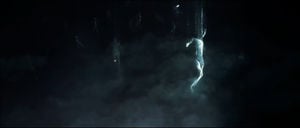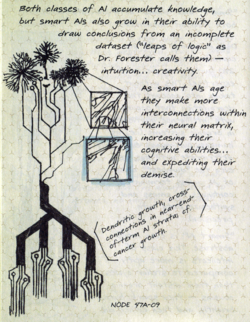Mind transfer
From Halopedia, the Halo wiki

Mind transfer is the process of duplicating or transferring the consciousness and memories of an individual from their original brain substrate into a digital or quantum-based computational system or another biological neural network. Through a simulation of the original brain's neural functions, the mind is able to continue its existence as a conscious and self-aware entity; in cases of advanced mind uploading, there is virtually no distinction between the original and the upload.
Once mastered and employed by the Forerunners to a great extent, a more limited form of mind uploading was later adopted by humanity as their only viable means of creating self-aware "smart" AIs.[1]
Forerunner[edit]
Terminology[edit]
In translations of Forerunner records, a mind, by itself and particularly when separated from its biological body, is often referred to as an essence;[2] this is in many ways comparable to the metaphysical concept of a soul, especially in contexts involving the Domain.[3] Pattern is a largely analogous term, although it appears to particularly emphasize the physical and quantifiable aspects of the neural and biological content;[4] essence referring more to the mind itself, with pattern being its organic or virtual framework. A pattern also often contains the complete information of the accompanying physical body in addition to the neural map.[5] The act of uploading the essence or pattern into another housing system is known as imprinting;[6] by extension, the product of this process is known as an imprint, although this term is often used interchangeably with the term pattern.[7] An impression is seemingly an incomplete or partial essence, containing assorted thoughts and memories from an individual's final moments.[8][Note 1] The uploading of a biological mind into a machine-based storage system has also been referred to as scanning[9] or sublimation in some contexts, with a machine designed to perform such transfers being referred to as a sublimation device.[2][10]
The primitive humans living in the Forerunners' time called their imprinted essences spirits, a rather apt descriptor in light of their existing cultural framework.[11]
General[edit]

The transfer and quantum foam-based storage[12] of mental content were ubiquitous in Forerunner society. The computing systems of the personal armor worn by virtually all Forerunners were integrated with the wearer's mind to such an extent that the Forerunner's consciousness virtually occupied the armor alongside their organic brain. The armor's dedicated AI construct—ancilla—was likewise melded with the wearer's mind and aided them in the organization of memories and other tasks. As an emergency measure, the armor could delete memories and experiences deemed excessively traumatic, or even "reset" the wearer's personality to its normal state in the event of external tampering with their brain.[13] In the rare event of the wearer's death, the armor would preserve the consciousness—or the final impressions of it—which would then traditionally be collected and placed into an "imprint matrix" known as a Durance.[14][15]
Thanks to the same integration, Forerunners could also upload offshoots of their consciousness to be housed in computing systems managed by ancillas; such an imprint could be created and uploaded into said systems at will within moments,[16] with the resulting intelligence being, for all intents and purposes, indistinguishable from the original mind. An example of a machine imprint created in this manner is the Librarian's stored essence she left on Requiem to guide future visitors.[17] Another personality imprint was left in a Lifeworker pod inside of Kilimanjaro on Earth. This imprint suggested that there were even more imprints out there that had gone to the Absolute Record. This imprint displayed the knowledge of the actions of her imprint on Requiem.[18]
War sphinxes retained impressions of the final moments of their deceased pilots. Although these essences were less complete than Durances, they were nonetheless preserved for study by Warrior commanders.[8][19] It was also a Warrior-Servant tradition to extract the memory impressions of their defeated enemies, partly for the purposes of interrogation.[20]
An automated sublimation device on X50 extracted the final patterns of Spartan Edward Davis during the Battle of Draetheus V in 2554.[10] Davis' impressions were placed into a Durance which was recovered by the UNSC at the conclusion of the battle.[21]
Full pattern uploading[edit]
Forerunners were capable of extracting not only an organic being's brain state, but also simultaneously retaining the complete pattern of their biological body.[5] The body could then be simulated—either virtually or in hard light form—so perfectly that the archived individuals themselves may potentially be left unaware of their incorporeal state.[9]
In the later stages of the Conservation Measure during the Forerunner-Flood war, the Lifeworkers used this form of pattern extraction technology to "store" individuals they did not have space for as raw data, to later recreate them from their virtual forms. The extraction process itself was gentle and painless, unlike that of the long-abandoned Composers.[22] On Installation 07, the Lifeworker known as Genemender Folder of Fortune scanned and archived himself as well as all humans he came across in this manner, lest they be exploited by the Master Builder. This technology also extracted and preserved the ancestral personality imprints the humans carried as part of the Librarian's geas. Genemender held the stored essences in stasis but occasionally "refreshed" them by allowing them to simulate physical interaction within his compound—itself largely a hard light simulation.[9] In the case of Genemender's station, specialized monitors were involved in the scanning process.[23]
The monitor later known as 343 Guilty Spark was created through a process of gradual uploading; Chakas' dying biological body was connected to a harness which gradually transferred his consciousness into the artificial computing system of a monitor. Chakas was conscious for some portions of this process and existed as a hybrid of his biological and virtual self for a time; for example, he found he was able to measure distances with exact accuracy while still connected to his body.[24] According to the IsoDidact, the intelligence Chakas would become—initially known as Monitor Chakas—would be capable of simulating physical sensations,[5] much like the archived humans in Genemender's village.[9]
In 2556, Dr. Genie Dawson and her UNSC science team from the Zeta Halo Project were sent to Lifeworker Central to study it. They were able to gain access to the Monolith Adjunct and hoped to study and catalogue the Forerunners' achievements in life sciences. Unfortunately, the scientists triggered an archiving process, resulting in their genetic patterns and consciousnesses being stored while their physical bodies were lost. The scientists were able to use hard light generators to manifest projections of themselves with likenesses so exact that it was nearly impossible to distinguish them from their biological counterparts. However, the team was limited to the Monolith Adjunct as the collapses left them cut off from many access points and Forerunner technology, including other control consoles that were still working.[25] With the help of Joyeuse and four UNSC technicians, the scientists were later downloaded into a salvaged submonitor carapace.[26]
Biological imprinting[edit]
Through the means employed in a mutation—the artificially-induced process through which Forerunners traditionally matured into higher forms—it was possible for the mentor to imprint their complete pattern over the Forerunner undergoing the mutation. This would transfer the mentor's essence and, in time, enable said essence to function within the host body. The imprinted Forerunner would also gradually grow into a physical facsimile of the mentor. By imprinting a Manipular known as Bornstellar Makes Eternal Lasting, the Ur-Didact created another incarnation of himself, who later supplanted the duties of his original.[7]
Despite the Forerunners' mastery of many related technologies, transferring a digitally-encoded personality into an inert biological body — "essence sheathing" — was expressly prohibited due to a number of risks inherent with this type of technology.[10] Nonetheless, a certain form of essence sheathing is known to have successfully taken place. The Librarian imprinted human essences extracted via Composers at the close of the Battle of Charum Hakkor into the genetic material of future human generations through a geas, the minds themselves dormant but programmed to awaken at the right triggers. Riser and Chakas were host to such essences; namely those of Yprin Yprikushma and Forthencho, respectively.[27]
Composer[edit]

The Composer was a sublimation device designed by the Builders as a means of saving Forerunners infected by the Flood. By broadcasting wide-ranging high-energy fields of entangled sympathies,[28] Composers retrieved their victims' patterns while reducing the targeted individuals to ash, also eradicating any Flood infection present. In the original design, new bodies would be grown for the extracted essences to inhabit. Unfortunately, the process was flawed and the essences could never be restored to biological form;[28] in addition to the Composer's inability to properly transcribe the essences in their new bodies, the Forerunners learned that any individuals afflicted by the Flood would also be corrupted on a metaphysical level, which caused the new bodies to rapidly decay and die.[29]
Nevertheless, the Composer found new uses; first as a means by the Old Council to punish the human survivors on Charum Hakkor, who had their essences forcibly harvested and then subjected to an endless interrogation rote for the next several thousands of years in order to decipher their supposed immunity or cure to the Flood.[30] Later, the Ur-Didact planned to wield the Composer as a weapon to convert all of humanity into mechanized slaves in order to forever neutralize them as a threat.[17]
Domain[edit]
The Forerunners' metaphysical information repository known as the Domain retained the essences of deceased Forerunners in an esoteric, transcendent state only partially accessible to living Forerunners.[31] The Forerunners believed that upon death, one's essence would be uploaded into the Domain where they would have access to the sum of all knowledge contained therein.[32] As the Domain was created by the Precursors as a means to collect all life-patterns and "living wisdom",[33] these beliefs may well hold true.
After being composed himself, the Ur-Didact would learn that this belief was true. The Didact was sent to the outer boundaries of the Domain where he learned that both the Forerunners who died and the humans who fell victim to the Composer -- both Ancestors and from the New Phoenix Incident -- had also been uploaded to the Domain. However, the damage to the Domain done by the Great Purification resulted in it shutting out nearly all of the Forerunners who perished in the Halo Array's firing, leaving them trapped in the outer boundaries with the Warden Eternal blocking entrance afterwards.[34] The one known exception to this was the Librarian who, as someone whose connections and contributions to Living Time exceeded all hopes and expectations, was pulled into the Domain when the Array was fired.[35] The Didact rallied the essences trapped outside of the Domain to destroy the Warden Eternal and reopen the Domain. Afterwards, the Didact welcomed the essences of both the Forerunners and humans into to Domain, giving them a home, a place to heal and rest, to commune and explore.[36][37][38]
Human[edit]

In Cognitive Impression Modeling, the process used to create smart AIs, a human brain is mapped and replicated into a digital storage system known as a Riemann matrix. The biological brain is necessary because human technology is unable to create a working neural architecture from scratch. As the neural tissue is destroyed in the process, the brains are almost invariably recovered from recently deceased "brain donors". The intelligence created through this process is not a perfect copy of the original; the scanned neural map is only used as the seed for the AI matrix, which will rewrite its neural map into a superior system within moments of its creation.[1] While fully developed smart AIs are effectively distinct entities of their own, they are known to retain memories and even certain personality traits of their donor individuals. These retained traits may include memories of specific events, or physical sensations: Sif, for example, likened wagons moving on "her" space tether strands to her brain donor's memory of grooming her own hair.[39]
Humans have also developed a procedure allowing the transfer of a living person's mental content to a cloned organic body. As part of her effort to create full human flash clones to replace the SPARTAN-II candidates, Dr. Catherine Halsey developed a technique through which a living person's memories can be transferred to a flash clone's brain, creating a clone that is virtually identical to their original host. This process used a "Fast Fourier Transform X-ray 3-D scan" to map a human brain's ionic density patterns. This data could then be used to create a virtual map of every individual link in a brain's neural pattern. This data would then be used in a deep-stimulating scan of a flash clone's "blank" brain, which would cultivate an identical pattern of linkages and accurately replicate the memories of the host person. Unfortunately, this memory replication results in an 82-percent rate of dementia, schizophrenia, and cancers in the recipient brain.[1]
Flood[edit]
Through unknowable mechanisms, the Gravemind—the Flood's collective intelligence—retains the consciousness and memories of past Graveminds even if the Flood on the whole is reduced into non-sentience in the interim. This process is seemingly unaffected by the passage of enormous spans of time; the Gravemind at the time of the Human-Covenant War possessed the memories of the one active during the Forerunner-Flood war.[40] Yet earlier, the archaic Gravemind and Precursor entity known as the Primordial experienced the passage of a billion years in a reverse timelock, its physical form disintegrating to dust due to entropy, only to reappear in the form of the "modern" Gravemind.[41]
Due to the nature of the Flood as a corrupt and fallen state of the Precursors, a transentient species who apparently allowed themselves to become extinct and revolve many times, the Flood may inherit a similar ability; the pattern and nature of the Gravemind remaining cohesive between individual and unconnected instantiations.
List of appearances[edit]
- Halo: The Fall of Reach (First mentioned)
- i love bees
- Halo 3 (Indirect mention)
- Halo: Contact Harvest (Mentioned only)
- Halo: Evolutions - Essential Tales of the Halo Universe
- Human Weakness (Mentioned only)
- Halo: Reach
- Data pads (Mentioned only)
- Halo: Cryptum
- Halo: Glasslands (Mentioned only)
- Halo: Primordium
- Halo: The Thursday War (Mentioned only)
- Halo 4
- Terminals
- Spartan Ops (Mentioned only)
- Halo: Silentium
- Halo: Spartan Assault
- Halo: Mortal Dictata (Mentioned only)
- Hunt the Truth
- Halo: Renegades (Mentioned only)
- Halo: Point of Light (Mentioned only)
- Halo: Epitaph (Mentioned only)
- Halo: Fifth Canticle (Mentioned only)
- Halo: Edge of Dawn (Mentioned only)
Notes[edit]
- ^ These terms are never exhaustively defined in The Forerunner Saga; the definitions presented here are largely derived from the context in which each term is used.
Sources[edit]
- ^ a b c Dr. Halsey's personal journal, May 3, 2526
- ^ a b Halo 4: The Essential Visual Guide, page 132
- ^ Halo: Primordium, page 234-235 ("But to all of us there is a time like this, when the Domain seeks to confirm our essences, and for you, that time is now")
- ^ Halo: Silentium, page 229
- ^ a b c Halo: Primordium, page 357
- ^ Halo: Silentium, page 224
- ^ a b Halo: Silentium, pages 28, 274
- ^ a b Halo: Cryptum, page 238
- ^ a b c d Halo: Primordium, pages 194-195
- ^ a b c Halo Waypoint: Catalog Interaction - Page 14
- ^ Halo: Primordium, page 155
- ^ Halo: Silentium, page 131
- ^ Halo: Silentium, page 161
- ^ Halo: Cryptum, page 47-48
- ^ Halo 4: The Essential Visual Guide, page 134
- ^ Halo: Silentium, page 297-299
- ^ a b Halo 4, campaign level Reclaimer
- ^ Halo: Renegades, chapter 48
- ^ Halo: Cryptum, page 138
- ^ Halo: Cryptum, page 188
- ^ Halo: Spartan Assault, campaign level Mission 30: The Source
- ^ Halo: Silentium, page 57
- ^ Halo: Primordium, page 193
- ^ Halo: Primordium, pages 359
- ^ Halo: Edge of Dawn, chapter 21
- ^ Halo: Edge of Dawn, chapter 40
- ^ Halo: Primordium, pages 224-226
- ^ a b Halo: Silentium, pages 40-41
- ^ Halo: Silentium, page 320 ("Composer-gathered essences have been imprinted over living humans; and those essences are now rotting the bodies from within, maligned by the Flood parasite.")
- ^ Halo: Silentium, page 43
- ^ Halo: Silentium, page 256
- ^ Halo: Silentium, page 55
- ^ Halo: Silentium, page 322
- ^ Halo: Epitaph, chapter 14
- ^ Halo: Epitaph, chapter 10
- ^ Halo: Epitaph, chapter 25
- ^ Halo: Epitaph, chapter 26
- ^ Halo: Epitaph, chapter 27
- ^ Halo: Contact Harvest, page 33
- ^ Halo 3, campaign level Halo 3 ("Resignation is my virtue; like water I ebb and flow. Defeat is simply the addition of time to a sentence I never deserved... But you imposed.")
- ^ Halo: Silentium, page 167 ("This being was not the Primordial I encountered on Charum Hakkor, but something else entirely-though it retained the Primordial's motives and thoughts and memories. It was a Gravemind-the Gravemind, more accurately. It was the Primordial's final act of revenge.")
| ||||||||